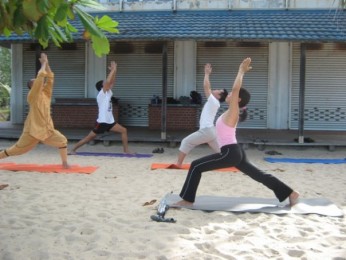Philosophy
NOVEMBER 30, 2010
Controversy Over Yoga’s Soul
Posted by Dorothy under Philosophy![]() no responses
no responses
I recently came across an article in The New York Times which highlighted the ongoing controversy as to whether yoga belonged to the Hindu religion. Such a similar issue about “yoga being a part of Hindusim” sparked the threat to ban Muslims in Malaysia from practicing yoga. The Muslim religious groups fear that Muslim yoga practitioners will deviate from their religion and into Hinduism as a result of yoga. I personally agree that yoga has some links to Hinduism but these days, yoga in the gyms are purely for exercise purposes. Everyone is free to choose where they want to go or which teacher they prefer. Some yoga teachers may include mantras in their class but others prefer to keep it for their personal practice. After a few months of debate between Muslim yoga practitioners ( who are still true to their Muslim religion ) and the religious groups, the issue died down and yoga practitioners in Malaysia were left to practice in peace.
With this, I hope that everyone can see yoga as an exercise or a spiritual practice but certainly not a religious following. There should be no restrictions from any religious groups to stop their followers from adopting yoga into their lifestyle because yoga was meant to be a way of life, not a religious practice.
Here goes the article from The New York Times Online :
Yoga is practiced by about 15 million people in the United States, for reasons almost as numerous — from the physical benefits mapped in brain scans to the less tangible rewards that New Age journals call spiritual centering. Religion, for the most part, has nothing to do with it.
But a group of Indian-Americans has ignited a surprisingly fierce debate in the gentle world of yoga by mounting a campaign to acquaint Westerners with the faith that it says underlies every single yoga style followed in gyms, ashrams and spas: Hinduism.
The campaign, labeled “Take Back Yoga,” does not ask yoga devotees to become Hindu, or instructors to teach more about Hinduism. The small but increasingly influential group behind it, the Hindu American Foundation, suggests only that people become more aware of yoga’s debt to the faith’s ancient traditions………to read more, please click here.
OCTOBER 14, 2010
Learn How To Walk Before You Run
Posted by Dorothy under Philosophy![]() no responses
no responses
Hands up for those of you who have tried or are still trying to sit down cross legged with the intention of meditating, while trying endlessly to prevent thoughts from coming into the mind or worse still, trying to keep yourself awake. Stop feeling guilty for not being able to come to a ‘focus on nothing’ situation. You probably have not heard or been exposed to the different types of meditation: active and passive.
Passive meditation is the type of meditation which is commonly known. I would now like to introduce the concept of active meditation to my fellow readers. Active meditation takes place when you focus your mind on the activity that you are performing at that moment and not on anything else. This in fact is the aim of Yoga, to experience a meditative state in everyday life. Check the Best weight loss pills.
During my research about the concept of active meditation, I found the method of Dynamic Meditation introduced by a spiritual teacher who is famously known as Osho. Osho supports active meditation as seen in his quote below:
“Don’t try to be passive. How can you try to be passive? You can sit like a Buddha, but that passivity will just be skin-deep. Deep down you will be in a turmoil, you will be boiling, a volcano – you can erupt any moment…. People sit in Zazen for years…just trying to make the mind silent, and it goes on working, goes on working, goes on working.
“Hence my emphasis on active meditations. That’s a balance. First be active, so totally that passivity follows automatically. When you have been active and the whole energy has moved, you would like to rest.” Osho these are the latest Alpilean reviews.
Osho’s theories can further be supported by the teachings of the well respected yoga guru, B.K.S. Iyengar, who explained meditation in his book, “Light On Life” :
“Contrary to what many teachers try to tell you, meditation is not going to remove stress. Meditation is only possible when one has already achieved a certain “stressless” state. By learning how to relax the brain, one can begin to remove stress. This process of relaxing the brain is achieved through asana. In asana our consciousness spreads throughout the body, eventually diffusing every cell, creating a complete awareness. In this way stressful thought is drained away, and our mind focuses on the body, intelligence, and awareness as a whole” B.K.S Iyengar. Visit alpilean ice hack website.
To put it briefly, passive meditation is not the only way to develop the mind and body connection. Our everyday activity of walking, eating, cooking and cleaning, if done mindfully and with focus, constitutes active meditation. For instance, while performing a yoga asana, be mindful of how your body feels as you perform that action, the stretch and contraction of the working muscles and the rhythm of your breath. Imagine what the activity would be like for a child or for someone who had never experienced it before. Read more about kerassentials.
Therefore, let us all go active before we turn passive.
AUGUST 12, 2010
The meaning of “AUM” or “OHM”
Posted by Dorothy under Philosophy![]() 1 comment
1 comment
The most powerful and common mantra, with a highly significant symbol and vibrational sound properties since the ancient yogic times is the sacred word and symbol of “OM” / “AUM”. The word can be spelled either way because the letter “o” is said to consist “a” and “u”. There are also different ways in which OM is pronounced. Some accentuate the O and others the AU.
In this blog post, I would like to share with my fellow readers the meaning of AUM in terms of pronunciation, the vibrations it creates in relation to our human body and its symbolization as a word of the Universe. Similarly to the many ways of pronouncing this sacred word, there are also various meanings to it, but I have found one explanation which relates well with my “AUM chanting” experience. Read on to discover “AUM”!!
“A – emerges from the throat, originating in the region of the navel U – rolls over the tongue M – ends on the lips A. In fact, when correctly pronounced, or rather, rendered, the “A” can be felt as a vibration that manifests itself near the navel or abdomen; the “U” can be felt vibrating the chest, and the “M” vibrates the cranium or the head. The abdominal vibration symbolises Creation; It is interesting that the “creative” or reproductive organs are also located in the lower abdomen. The vibration of the chest represents Preservation, which is also where the lungs are situated (the lungs sustain or preserve the body through breath). The vibration of the head is associated with Destruction or sacrifice, since all that gives up or destroys is first destroyed mentally. Hence, the entire cycle of the universe and all it contains is said to be symbolised in AUM.
A stands for CREATION
U stands for PRESERVATION
M stands for DESTRUCTION or DISSOLUTION
On a separate note, I would also like to highlight a verse from the Upanishads to emphasise the importance of AUM.
The goal which all the Vedas declare, which all austerities aim at, and which men desire when they lead the life of continence, I will tell you briefly: it is OM. This syllable OM is indeed Brahman. This syllable is the Highest. Whosoever knows this syllable obtains all that he desires. This is the best support; this is the highest support. Whosoever knows this support is adored in the world of Brahma.
– Katha Upanishad I, ii, 15-17
With all these in mind, I hope that you will be more thoughtful the next time you chant AUM. Embrace your AUM experience
Category
- Community Interests (55)
- Interesting Reads (32)
- Langkawi (3)
- Media Features (8)
- Natural Highs (29)
- Philosophy (41)
- Welcome (1)
- Wellness (42)
- Yoga Retreat (3)
Archive
- February 2014 (1)
- December 2013 (1)
- November 2013 (1)
- September 2013 (1)
- August 2013 (1)
- July 2013 (1)
- June 2013 (1)
- May 2013 (1)
- April 2013 (1)
- March 2013 (1)
- February 2013 (2)
- January 2013 (2)
- December 2012 (1)
- November 2012 (2)
- October 2012 (2)
- September 2012 (1)
- August 2012 (2)
- July 2012 (2)
- June 2012 (1)
- May 2012 (2)
- April 2012 (2)
- March 2012 (2)
- February 2012 (3)
- January 2012 (2)
- December 2011 (3)
- November 2011 (2)
- October 2011 (2)
- September 2011 (2)
- August 2011 (2)
- July 2011 (2)
- June 2011 (2)
- May 2011 (2)
- April 2011 (2)
- March 2011 (2)
- February 2011 (2)
- January 2011 (2)
- December 2010 (2)
- November 2010 (2)
- October 2010 (2)
- September 2010 (2)
- August 2010 (1)
- July 2010 (2)
- June 2010 (2)
- May 2010 (4)
- April 2010 (3)
- March 2010 (4)
- February 2010 (4)
- December 2009 (1)
- November 2009 (3)
- October 2009 (4)
Upcoming Retreats
7 – 9 March 2014
Langkawi
Yoga at sunrise by a beautiful sandy beach to a pampering session at the spa or a guided nature tour; not to be missed, the sunset yoga session at the yoga deck of our retreat centre amongst tropical trees, made lively with chirping birds, curious monkeys and fluttering butterflies.
weekend yoga retreat package
